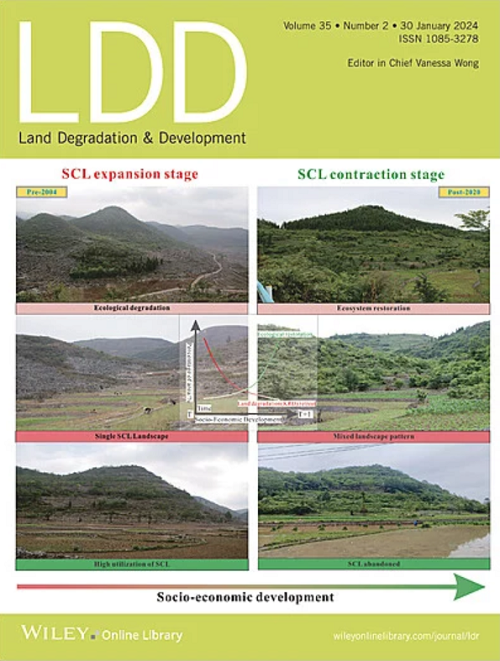库仑-喜马拉雅地区树线过渡带植物多样性格局和植被结构的地形与土壤因素
IF 3.6
2区 农林科学
Q2 ENVIRONMENTAL SCIENCES
引用次数: 0
摘要
林带过渡带是生态敏感的生态系统,越来越容易受到最近全球变暖和土地退化过程的影响,如土壤侵蚀、养分枯竭和有机质流失。然而,对于树线过渡带的植物多样性如何响应变化的环境因子,特别是在喜马拉雅高海拔的树线过渡带,人们知之甚少。本文研究了地形和土壤因子对库仑-喜马拉雅两峰顶林木线过渡带植被结构的潜在影响。利用样线、样地和样方等方法,共记录到36科72属96种植物。Jaccard相似系数揭示了不同坡面和海拔间物种组成的相似程度不同。Beta多样性分析表明,巢性是群落组成的主要驱动因素。植被评价显示树木密度(12.50 ~ 227.50株/公顷)、基面积(0.138 ~ 9.855平方米/公顷)和分布格局在海拔梯度上发生了变化。所有样地的优势树种均为杜鹃(Rhododendron arboreum)。再生很明显,69%的树木在较小的周长类别中,表明积极的招募。除了植被分布外,本研究还分析了整个树线过渡带的土壤特征,以评估潜在的土地退化趋势。土壤温度、pH值、水分和保水能力随海拔升高而降低。南侧和东侧温度、pH值和磷含量较高,北侧和西侧湿度、有机碳和氮含量较高。结果表明,在高海拔和暴露面,土壤湿度下降、容重增加和总有机碳下降表明了可能影响植被长期稳定性的退化过程。土壤参数与物种分布之间的重要关系突出了理解退化动态对形成植物区系格局的重要性。基于环境变量(应力值:0.17)的非度量多维尺度(NMDS)显示出明显的树线图聚类,而典型对应分析(CCA)显示出强的物种-环境相关性,解释了总惯性的83.08%。鉴于观察到的土壤退化趋势,保护策略应优先考虑土壤稳定、侵蚀控制和养分枯竭,以减轻生态系统退化的风险。该研究为生态系统恢复力提供了重要的见解,并为监测环境条件变化下的林带过渡带奠定了基础。本文章由计算机程序翻译,如有差异,请以英文原文为准。
Topographic and Edaphic Factors Shaping Floral Diversity Patterns and Vegetation Structure of Treeline Ecotones in Kumaun Himalaya
Treeline ecotones are ecologically sensitive ecosystems that are increasingly vulnerable to recent global warming and land degradation processes such as soil erosion, nutrient depletion, and organic matter loss. However, little is known about how floral diversity in treeline ecotones responds to changing environmental factors, particularly in the high Himalayan treeline ecotones. The present study examined the potential effects of topographic and edaphic factors on the vegetation structure of treeline ecotones of two mountain summits in Kumaun Himalaya. Using line transects, plots, and quadrats, we recorded 96 plant species from 72 genera and 36 families. Jaccard similarity coefficients revealed varying degrees of similarity in species composition between different aspects and elevations. Beta diversity analysis indicated nestedness as a dominant driver of community composition. Vegetation assessments showed shifts in tree density (ranging from 12.50 to 227.50 individuals per hectare), basal area (ranging from 0.138 to 9.855 square meters per hectare), and dispersion patterns along the elevational gradient. The dominant tree species across all treeline ecotone plots was Rhododendron arboreum . Regeneration was evident, with 69% of trees in smaller girth classes, indicating active recruitment. In addition to vegetation distribution, this study analysed soil characteristics across the treeline ecotones to assess potential land degradation trends. Soil temperature, pH, moisture, and water holding capacity decreased with elevation. South and east aspects had higher temperatures, pH, and phosphorus, while north and west aspects had higher moisture, organic carbon, and nitrogen. Results indicate that decreasing soil moisture, increasing bulk density, and declining total organic carbon at higher elevations and exposed aspects are indicative of degradation processes that may impact long‐term vegetation stability. The significant relationships between soil parameters and species distribution highlight the importance of understanding degradation dynamics in shaping floristic patterns. Non‐metric multidimensional scaling (NMDS) showed distinct clusters of treeline plots based on environmental variables (stress value: 0.17), while canonical correspondence analysis (CCA) demonstrated strong species‐environment correlations, explaining 83.08% of the total inertia. Given the observed soil degradation trends, conservation strategies should prioritize soil stabilization, erosion control, and nutrient depletion to mitigate the risks of ecosystem degradation. This research provides key insights into ecosystem resilience and serves as a foundation for monitoring treeline ecotones under changing environmental conditions.
求助全文
通过发布文献求助,成功后即可免费获取论文全文。
去求助
来源期刊

Land Degradation & Development
农林科学-环境科学
CiteScore
7.70
自引率
8.50%
发文量
379
审稿时长
5.5 months
期刊介绍:
Land Degradation & Development is an international journal which seeks to promote rational study of the recognition, monitoring, control and rehabilitation of degradation in terrestrial environments. The journal focuses on:
- what land degradation is;
- what causes land degradation;
- the impacts of land degradation
- the scale of land degradation;
- the history, current status or future trends of land degradation;
- avoidance, mitigation and control of land degradation;
- remedial actions to rehabilitate or restore degraded land;
- sustainable land management.
 求助内容:
求助内容: 应助结果提醒方式:
应助结果提醒方式:


